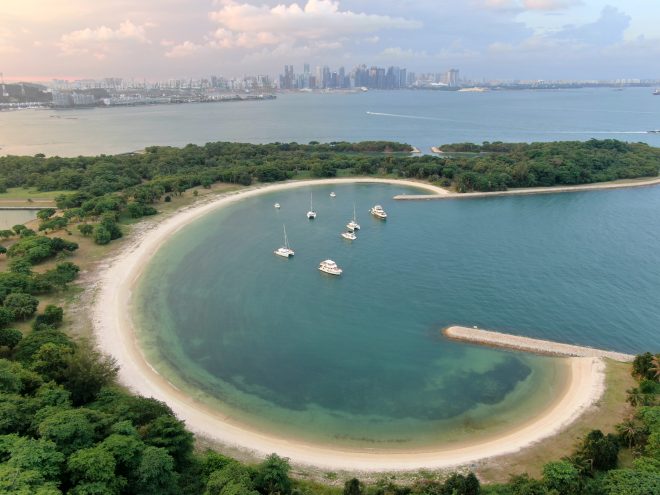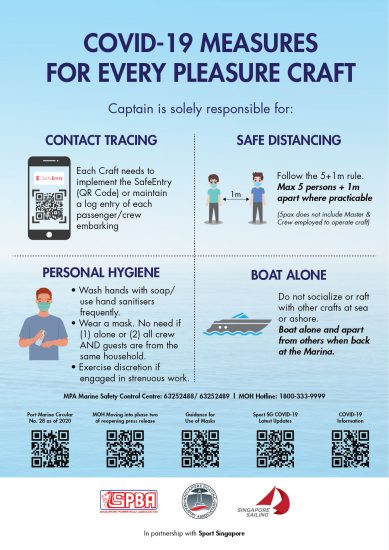As I write this, Singapore is in Phase Two of the re-opening measures introduced after the easing of our enforced circuit breaker. Boating activities can resume as part of this phase.

Yachts gather at Singapore’s Lazarus Islands before the onset of Covid-19 this year; Photo: Wade Pearce / Next Tide Consultancy
The Singapore Boating Industry Association (SBIA) has been making the point to our government agencies that seaports and sailing are healthy outdoor activities for the family that readily conform to Covid-19 safety measures. Indeed, MP Tan Bee Wah made this point in Parliament in her speech on June 4.
By now, it has been drilled into us to expect a new post-pandemic normal. So, it should come as no surprise that boating the other side of Covid-19 will come with caveats, as is the case of countries that have resumed boating ahead of us.
In Singapore, the measures that boaters must follow can be distilled into four key areas:
- Contract Tracing: Each boat must maintain a register to enable contact tracing if the need arises (for businesses, this can be a SafeEntry QR Code).
- Safe Distancing: Not more than five people on board, excluding employees hired to operate the boat such as captain and crew. Where possible, practise safe distancing by following the 1m apart rule.
- Personal Hygiene: Keep hands and surfaces sanitised. When practicable, wear a mask if there are guests on board who are not from the same household.
- Boat Alone: Do not socialise on the marina pontoon or raft-up with other boats at sea.
An infographic has been developed to help promote this message, the full text of which is contained in the links provided by the QR Codes in the poster.

Many clubs are reminding members that BCPs (Business Continuity Plans) may mean that employees may be divided into teams and are therefore working at half the normal staff strength. This, in addition to health screening measures, puts a strain on operations.
At the same time, members must be patient and allow more time transiting from their club to their boat. Many marinas also require that boats leaving and returning to the marina call ahead, so that an orderly queue can be maintained and relieve congestion which could lead to the breakdown of safe distancing.
Many other countries have reported that boat owners have returned to the water in huge numbers after being closeted at home. The claustrophobic effect of a forced lockdown has led to a yearning for open spaces and a human reconnection with nature – boating and watersports certainly deliver on both these fronts.
It is not clear, however, how long this pent-up feeling to embrace the great outdoors will last. But it is a window of opportunity for boating to showcase and promote its healthy outdoor side.
Once past the immediate post-lockdown surge, the outlook might be less bright, reflecting the sentiments of the weak economy. We have seen in previous downturns (think Asian Financial Crisis or SARS), that conspicuous consumption was frowned upon.
For example, in Thailand, politicians pandering to the populist vote introduced a boat tax which dealt a crippling blow to boating businesses in the country. This time, there is the added complication of disrupted supply chains as manufacturers return to boatbuilding, which may have significant impact on new boat sales worldwide.
Despite many boat shows being cancelled or postponed in the first half of 2020, dealers in many countries including Singapore are reporting an uptick in sales and enquiries. The Singapore Yacht Show was – among many international shows – forced by the pandemic to be postponed (the new dates are October 22-25).
Boat shows are an important outreach by the industry to prospective buyers and the public. They generate interest and excitement, keeping boating top-of-mind. They are the industry’s shop window where consumers can feel and touch the product. Unlike the automobile industry where you can go into a showroom at any time, boats are on display only a few times a year in this part of the world.
Dealers depend on shows to build and update their database of prospects, which they then develop throughout the year to convert to sales. Having said that, the nature of shows may well change after Covid-19. The need for safe distancing and the limitation on the size of gatherings may lead to smaller “distributed” shows. Virtual boat showrooms have also sprung up in the online sphere, accessible globally and often on-demand.
The profile of boaters has also changed with the average age of the boater rising worldwide, as fewer young people take to boating. One key insight is that millennials are more likely to purchase experiences rather than product.
However, boat shows are slow to seriously embrace the selling of boating experiences rather than boats. With or without shows, the overall industry needs to strategise on how best to win over new converts and reverse this trend. Covid-19 may well be a catalyst that accelerates this change.
The coronavirus has undeniably affected every strata of society. It has placed great emphasis on personal health, resilience and well-being. The impetus for change, be it a return or a conversion to boating, might perhaps be more intrinsic as may be suggested by research, both previous and emerging, on the health benefits of being out with nature.
Many such studies have shown that people who reside near water fare better than those who stay inland. Author Wallace J. Nichols expounds in his book Blue Mind: “Simply the mere sight and sound of water promotes wellness by lowering cortisol, increasing serotonin and inducing relaxation”.
Around the world, boating associations and communities are today initiating campaigns promoting the return to the activity, governed by measures to safeguard the interest of boaters, service providers and the general public. Every individual has a role to play in keeping boating safe and accessible for everyone.
For enquiries, email: [email protected]
YP Loke is the Chairman of the Singapore Boating Industry Association and serves as Vice-President on the Raffles Marina General Committee. A naval architect by training, he is part of the Global Marine Business Advisors alliance and heads up Spinnaker International, which consults on boating and marina matters.